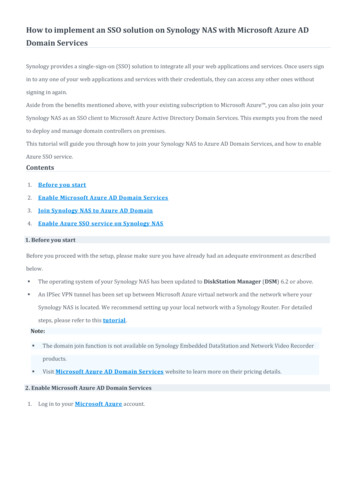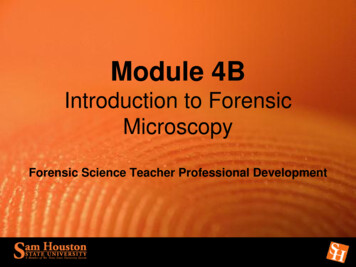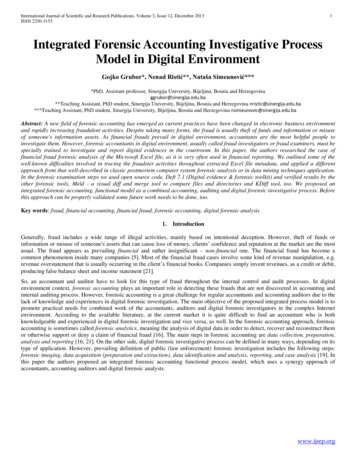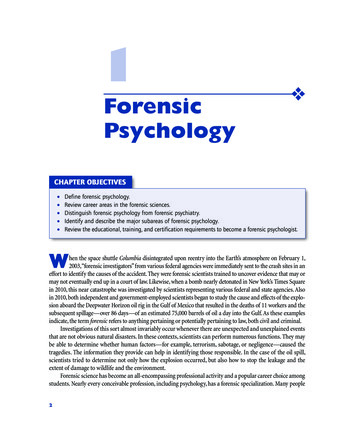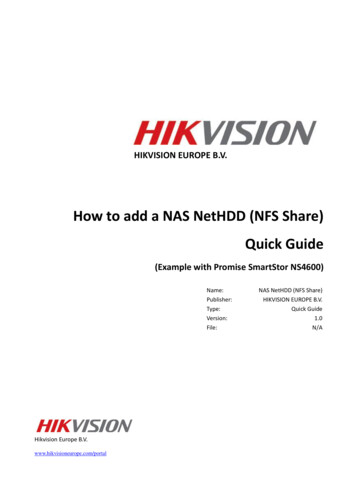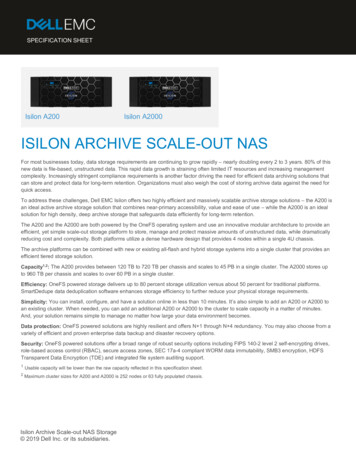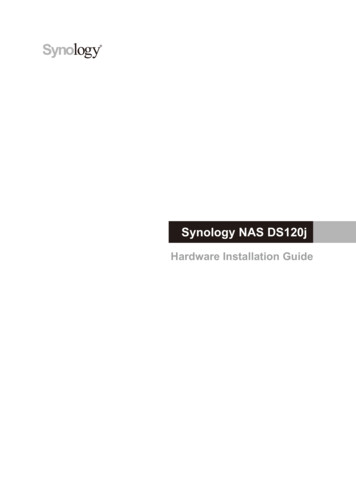
Transcription
THE NAS REPORT ON FORENSIC SCIENCE:A FORENSIC SCIENTIST’S RESPONSEBrent E. Turvey, MS1Crime ReconstructionPublished: February 25, 2009Forensic scientists come in many forms, and their numbers include many examinerswho do not work in crime labs. They also lack uniform standards in education andmethodology; their conclusions often lack scientific rigor and are overly confident;and they are too often marked by improper alignment with law enforcement andprosecutorial agencies. As consequence, the forensic science community isfragmented and broken, cannot identify let alone fix its own problems, and does notspeak with a single voice about what is best for its future. Moreover, it has provenincapable of holding itself accountable for anything that it does. Such are the findingsin the recently published report by the National Academy of Science (NAS),Strengthening Forensic Science in the United States: A Path Forward (Edwards andGotsonis, 2009). Subsequently, it falls to those of us who are relatively free torespond of their own accord, without political affiliation, censure, or fear of reprisal,to do so. This commentary is prepared in that spirit.CONTEXTFirst, as a forensic scientist, I am deeply grateful for theefforts of the NAS Committee on Identifying the Needs of theForensic Science Community in conducting their inquiry. I amalso grateful to the United States Congress, which providedthe necessary funding. Those of us practicing science in thiscommunity have waited a long time for an impartial andcritical review by fellow scientists.Forensic scientists offering similar critical findings andrecommendations (see Chisum and Turvey (2007), cited inCrime Reconstructionthe NAS report) have previously been shouted down and evenElsevierScience - 2007sanctioned with false ad hominem attacks sponsored by someof the professional organizations discussed in the NASReport2. Many prominent legal scholars have also been afforded like treatment fordeigning to publish their research on bias, error, and the overall absence of scientificmethodology in forensic science. The NAS Committee, it would seem, suffered to1Brent E. Turvey is the senior partner of Forensic Solutions, LLC. He holds an MS in ForensicScience, and has been a forensic scientist in private practice since 1996. A generalist, he alsospecializes in crime reconstruction and crime scene analysis, and has given expert testimony in courtsacross the United States. He is the author of numerous scholarly texts and journal articles on forensicscience subjects, including Crime Reconstruction (Elsevier, 2007) with W. Jerry Chisum. It should benoted that Mr. Chisum, a past president of ASCLD and the California Association of Criminalists,served as a peer reviewer for the NAS report. Forensic Solutions, LLC: www.forensic-science.com.Mr. Turvey can be reached for comment at: bturvey@forensic-science.com.2For example, see Gardner, R. (2007) “Crime Reconstruction” Journal of Forensic Identification, 57(6), pp.797-806 and Chisum, W.J. and Turvey, B. (2008) “Re: The Commentary “CrimeReconstruction”” Journal of Forensic Identification, 58 (2), pp.133-155.
overcome the same political environment. And it literally took an act of Congress toprevail, as explained in Moore (2009):Donald Kennedy, a Stanford scientist who helped select the report’s authors, said federal lawenforcement agencies resented “intervention” of mainstream science — especially theNational Academy — in the courts.He said the National Institute of Justice, a research arm of the Justice Department, tried toderail the forensic study by refusing to finance it and demanding to review the findings beforepublication. A bipartisan vote in Congress in 2005 broke the impasse with a 1.5 millionappropriation.So on behalf of myself, and many colleagues practicing silently and under politicalduress to toe the agency line in law enforcement affiliated crime labs across thenation, I thank you for this much needed support.Second, it is important to bear in mind that because the majority of governmentfunded crime labs are law enforcement affiliated there can be very little objectiveresponse to the NAS Report from the forensic science community at large. Those whowant change can’t voice it for fear of political sanction, or because speaking publiclyabout their concerns may somehow violate agency policy. Just as common, many atthe supervisory level have a vested interested in the status quo, which is why thingshaven’t changed for so long and an independent inquiry was needed. Worse, there aresome individuals and agencies in the forensic community who believe themselvesabove external critique or review who will continue to act as they always have – withimpunity. These are the very professionals and groups that are, as explained in theNAS Report (Edwards and Gotsonis, 2009; p. S-13) “too wedded to the current“fragmented” forensic science community, which is deficient in too many respects.”It should be mentioned that as of this writing there have been a few public responsesto the NAS Report from the larger forensic science organizations, such as the AAFS,SOFT, the IAI, and ASCLD. These responses, while positive, have been ridiculouslybrief and amount to little more than public relations with a positive spin. In fact,reading them one gets the distinct impression that these organizations agree with theNAS Report and that they are already in step with its recommendations. Were thistrue, the findings of the report would have been much different. The recent pressreleases issued by these organizations collectively ignore the well-founded criticismsin the NAS Report, their own deep law enforcement affiliations or culture that thereport warns against and argues must be abolished, and their complicity in creatingand even fostering the current broken forensic environment. For instance, the NASReport observes (Edwards and Gotsonis, 2009; p.2-19):The forensic science community lacks the necessary governance structure to pull itself upfrom its current weaknesses. Insufficiencies in the current system cannot be addressed simplyby increasing the staff within existing crime laboratories and medical examiners offices. Ofthe many professional societies that serve the forensic science community, none is dominant,and none has clearly articulated the need for change or presented a vision for accomplishing it.And clearly no municipal or state forensic office has the mandate to lead the entirecommunity. The major federal resources—NIJ and the FBI Laboratory—have providedmodest leadership, for which they should be commended. NIJ has contributed a helpfulresearch program and the FBI Laboratory has spearheaded the SWGs. But again, neitherentity has recognized, let alone articulated, a need for change or a vision for affecting it.Neither has the full confidence of the larger forensic science community. And because both
are part of a prosecutorial department of the government, they could be subject to subtlecontextual biases that should not be allowed to undercut the power of forensic science.Ironically, some of these professional organizations also seem to now have theirhands out for funding of one type or another, as though the conclusion of the NASReport was that funding a broken system, and the partisan organizations that helped tobreak it, was its proposed solution.Funding any part of the forensic science community without meaningful change is awaste of time, effort, and resources. An acknowledgement of shortcomings and totalregime change away from law enforcement governance must be part of that changefor any existing organization that seeks funding or acknowledgement under thebanner of forensic science. Similarly, anything that serves only or primarily theinterests of law enforcement must be excised.Third, because of the explosive content of the NAS Report and, unfortunately, itslength, many in the forensic community are not reading it very carefully. Still othersare reading it selectively. Many more, however, will not read it at all. As aconsequence, false statements about the report’s authors and content are alreadysurfacing – such as “it has nothing to do with DNA”, and “it was written by peoplewho don’t understand forensic science”, and “the only detractors of forensic scienceare its adversaries in court.” Such assertions, made by the ignorant or partial, areintended to keep subordinates and colleagues from reading the report. Or to blunt itsfindings as somehow stemming from the adversarial nature that has come tocharacterize forensic science culture because of its appropriation by lawenforcement3.There are also published responses from various law enforcement and prosecutorialcommunity that the NAS Report does not bear on certain labs and examiners. Theirreasoning indicates that they haven’t read it, don’t understand it, or are intentionallymisrepresenting it’s contents. Take for example the reassurances coming out ofLarimer County, Colorado (Taylor, 2009):Fort Collins Chief of Police Dennis Harrison said he's confident in both CBI analysis and4analysis by regional fingerprint examiners ."As far as fingerprint work goes, I'm not concerned because they have to follow a pretty strictprotocol that can be rereviewed by defense attorneys," he said. Larimer County District Attorney Larry Abrahamson said he's confident in the analysis beingdone by the Colorado Bureau of Investigations and other law enforcement laboratories. Abrahamson said any forensics expert asked to testify has to be qualified as an expert by ajudge based on training, and forensic conclusions are usually reached by more than oneexaminer.3See Chisum and Turvey (2007; p.xiv): “The paradigm of sides presents the forensic scientist with afalse choice between prosecution or defense; between scientific fact or legal truth. Pressure to choosecan be brought to bear in many ways—personal, professional, and financial. Furthermore, the pressureon a forensic scientist in such environments, to be part of the “team” and help “get the bad guys,” canbe seductive and overwhelming to the point of assimilation.”4The Colorado Bureau of Investigation (CBI) is a state law enforcement agency with its own crimelab, supervised by sworn agents of the CBI; url: http://cbi.state.co.us/lab/default.asp.
"Very seldom do we rely solely on the conclusions of the expert," Abrahamson said. "In mostevery case there has to be supporting evidence apart from the forensic evidence."Often when there is expert testimony regarding an item in controversy the jury will have theopportunity to hear from both a prosecution expert and an expert hired by the defense. If thereare differences in opinion the jury will have to make the decision."Positions such as these, largely from law enforcement and those currently benefitingfrom the broken forensic system, ignore a fundamental concern of the report: theunacceptable subordination of forensic science to law enforcement oversight, whichcan cause bias even across multiple examinations of the same item of evidence.Moreover, such statements ignore the report’s finding that courts, and the adversarialprocess, are not up to the task of determining scientific reliability or validity – onlylegal admissibility. Though many jurists often confuse the two. As explained in theNAS Report (Edwards and Gotsonis, 2009; pp. S-19):The adversarial process relating to the admission and exclusion of scientific evidence is notsuited to the task of finding “scientific truth.” The judicial system is encumbered by, amongother things, judges and lawyers who generally lack the scientific expertise necessary tocomprehend and evaluate forensic evidence in an informed manner, trial judges (sitting alone)who must decide evidentiary issues without the benefit of judicial colleagues and often withlittle time for extensive research and reflection, and the highly deferential nature of theappellate review afforded trial courts’ Daubert rulings. Given these realities, there is atremendous need for the forensic science community to improve. Judicial review, by itself,will not cure the infirmities of the forensic science community.The point, which cannot be stressed enough, is reiterated later in the report with lessdiplomacy (p.1-14):The bottom line is simple: In a number of forensic science disciplines, forensic scienceprofessionals have yet to establish either the validity of their approach or the accuracy of theirconclusions, and the courts have been utterly ineffective in addressing this problem. For avariety of reasons—including the rules governing the admissibility of forensic evidence, theapplicable standards governing appellate review of trial court decisions, the limitations of theadversary process, and the common lack of scientific expertise among judges and lawyerswho must try to comprehend and evaluate forensic evidence—the legal system is ill-equippedto correct the problems of the forensic science community. In short, judicial review, by itself,is not the answer.Consequently, any police agency or prosecutor arguing that their forensic analysts arereliable and trustworthy because they have been qualified by the court and crossexamined by the defense in response to the NAS Report telegraphs precisely the kindof ignorance the report warns against. But of course those vested in the current systemare going to claim the report is irrelevant and that they aren’t concerned about theirown forensic personnel. Anything else is an admission that findings from theirforensic personnel are the result of unproven methods and overconfident findingsfrom under-trained, overworked, and too often biased analysts. This would put theirrespective court cases in jeopardy. Which of course is precisely the case.It is my great hope that forensic professionals of all types, and their students, will readthe NAS Report for themselves. In doing so they will find that it is intensely relevantto their work and study, regardless of their specialization. They will also find that it is
the result of scientists working in the interest of good science – with advice andcounsel from many different actors in the forensic community.COMMENDATIONSAs already mentioned, the NAS Report was a welcome scientific rendering of thecurrent state of forensic science in the United States. The only professionals that willhave a problem with its findings are those vested in maintaining law enforcementcontrol over the forensic community while being unfamiliar with the nature and needsof actual science. Unfortunately, as the report makes all too clear, that number is inthe majority. If it weren’t, things would have been able change from within and theNAS Report would have been completely unnecessary.From this forensic scientists perspective, there are many areas where the committee isto be commended for spelling things out and taking a stand. They will be helpful tothe forensic science community, the courts, and all students seeking careers in thecriminal justice system. These areas include, but are certainly not limited to, thefollowing:ScienceChapter 4 of the NAS Report is entitled “The Principles of Science and InterpretingScientific Data”. The inclusion of an entire chapter on a subject this fundamental isimportant for a number of reasons. It makes clear what science is, what it involves,and defines it as a culture with its own philosophy, mission and objectives. Asprovided in the NAS Report (Edwards and Gotsonis, 2009; p.4-11):The methods and culture of scientific research enable it to be a self-correcting enterprise.Because researchers are, by definition, creating new understanding, they must be as cautiousas possible before asserting a new “truth.” Also, because researchers are working at a frontier,few others may have the knowledge to catch and correct any errors they make. Thus, sciencehas had to develop means of revisiting provisional results and revealing errors before they arewidely used. The processes of peer review, publication, collegial interactions (e.g., sharing atconferences), and the involvement of graduate students (who are expected to question as theylearn) all support this need. Science is characterized also by a culture that encourages andrewards critical questioning of past results and of colleagues. Most technologies benefit froma solid research foundation in academia and ample opportunity for peer-to-peer stimulationand critical assessment, review and critique through conferences, seminars, publishing, andmore. These elements provide a rich set of paths through which new ideas and skepticism cantravel and opportunities for scientists to step away from their day-to-day work and take alonger-term view. The scientific culture encourages cautious, precise statements anddiscourages statements that go beyond established facts; it is acceptable for colleagues tochallenge one another, even if the challenger is more junior. The forensic science disciplineswill profit enormously by full adoption of this scientific culture.Its inclusion is also a clear admission that the mandates of good science need to bewritten out and explained. This is because they are so poorly understood both withinthe forensic science community and amongst its end-users – the courts and lawenforcement. And finally, the report makes clear at multiple points that forensicscience is often developed and practiced outside of scientific culture, and that theforensic community has yet to fully embrace these mandates.This is an echo of warnings expressed in Thornton and Peterson (2002), that forensicscientists are rarely trained in the scientific method, do not understand its
implications, and that this ignorance leads to its abuse5. Similarly concerned, Chisumand Turvey (2007) wrote (p.85) “most practicing [forensic examiners] wouldprobably have a great deal of enthusiasm for strict adherence to standards thatembrace diminished bias, analytical logic, and the scientific method, if only theyunderstood what these things are.”The NAS Report also provides for the need to separate the forensic sciencecommunity from law enforcement culture. This is discussed in many sections, and allthroughout Chapter 6, “Improving Methods, Practice, and Performance in ForensicScience”, where it is explained (Edwards and Gotsonis, 2009; p.6-1):The majority of forensic science laboratories are administered by law enforcement agencies,such as police departments, where the laboratory administrator reports to the head of theagency. This system leads to significant concerns related to the independence of the laboratoryand its budget. Ideally, public forensic science laboratories should be independent of orautonomous within law enforcement agencies. In these contexts, the director would have anequal voice with others in the justice system on matters involving the laboratory and otheragencies. The laboratory also would be able to set its own priorities with respect to cases,expenditures, and other important issues. Cultural pressures caused by the different missionsof scientific laboratories vis-à-vis law enforcement agencies would be largely resolved.Finally, the forensic science laboratories would be able to set their own budget priorities andnot have to compete with the parent law enforcement agencies.The NAS Committee’s recognition of the incompatibility between scientific and lawenforcement / prosecutorial goals, and the bias this can and has created, is perhaps itsmost significant contribution to the future of the forensic science community. This isconsistent with the discussion found in Cooley and Turvey (2007; p.79):To correct institutional bias, which accounts for many of the unwanted observer effectsdiscussed in this chapter, it may be time to consider separating the forensic scientist once andfor all from police culture. In other words, it may be time to consider separating all state crimelab systems physically, philosophically, and fiscally from law enforcement and to advocate forthe creation of wholly independent state divisions of forensic science that are publicly fundedbut available to all.The idea is not new. [Dr. Paul L.] Kirk and [Lowell] Bradford (1965, pp. 22–23)advocated for independent crime labs four decades ago24:An independent operation, not directly a part of any other law enforcement agency, butavailable to all, would certainly find it easier to maintain the high degree of scientificobjectivity that is so essential to good operation. It is very probable that the quality of servicefurnished would be higher than is now possible, because there would be no dependence onbudgets of the other organization with their inevitable competition for available funds, andthere would be no question of comparable rank of personnel, which is a problem in someorganizations under the common American system.Fn 24 - Similarly, Professor [James] Starrs (1993) urged that the “inbred bias of crimelaboratories affiliated with law enforcement agencies must be breached.” Professor [Paul]Gianelli (1997) also advocated for independent crime labs, stating, “These laboratories shouldbe transferred from police control to the control of medical examiner offices, agencies that arealready independent of the police.”If forensic scientists take nothing else from the NAS Report, let it be that sciencecannot not survive, and therefore does not belong, in the culture of law enforcement.5Dr. Joseph L. Peterson is referenced multiple times in the NAS Report, and also presented before theNAS Committee as part of their inquiry.
Error RatesIn May of 2005, I composed a brief email to an email discussion list dedicated toforensic science issues: forensic-science@yahoogroups.com. Responding to a threadon the accuracy of forensic science, I wrote a simple yet bitter fact that was not wellreceived:[Dr. John I.]Thornton wrote once that "if there is no science, there can be no forensic science."At some point we are going to have to live up to this. And we are going to have to startdefining the legitimate role and limits of forensic science with more integrity. Like forexample, being upfront with the fact that error rates for crime lab testing on all levels areessentially unknown.This sparked a heated debate that lasted for a month and ended without end. At thetime, Dr. John Thornton was the only forensic scientist I know of who wasunequivocally on record about the lack of a known error rate in crime labs across thecountry, discussed in his landmark article on the Daubert decision (Thornton, 1994).Now, with the publication of the NAS Report, we have reached that point wherebelligerent ignorance must give way to scientific reality.Too many in the forensic science community have falsely believed and testified thatthe error rates of their methods and examinations are essentially zero or are toocomplex for measurement. As such, it is argued, they neednot be studied at all. This misconception about error ratesand whether they may be reliably gauged, or relevant, oftenstarts at the top. The seed of arrogance and ignorance ofsenior examiners is planted in the forensic community – insoil of loyalty or fear. It is gathered and spread as juniorexaminers are trained to parrot responses that they cannotquestion and do not understand. Once this happens enoughtimes on the record, they are vested and stuck for life withthe errors of previous testimony. Consider, for example, thecontinued testimony of Dr. Bruce Budowle, the FBI’s topforensic scientist6. He has, on numerous occasions, testifiedDr. Bruce Budowlein precisely the fashion warned against by the NAS Report.FBI Crime LabAs provided in U.S. v. Llera Plaza et al (2002; p.510):Dr. Budowle's testimony with respect to methodology error was as follows:Q: Tell us how it [error rate] applies to scientific methods, methodology.A: Well, this transcends all kinds of forensic, it transcends all disciplines in that, but in theforensic area particularly, this has been an issue discussed repeatedly in lots of disciplines,whether it is DNA chemistry and latent fingerprints.We have to understand that error rate is a difficult thing to calculate. I mean, people are trying6Dr. Bruce Budowle is referenced multiple times in the NAS Report, and also presented before theNAS Committee as part of their inquiry. Apparently the NAS Committee disagreed with his opinionsregarding the need to study error rates, and whether they are in fact essentially zero. That is, unless hetold them something different.
to do this, it shouldn't be done, it can't be done An error rate is a wispy thing like smoke, it changes over time because the real issue is, didyou make a mistake, did you make a mistake in this case? If you made a mistake in the past,certainly that's valid information that someone can cross-examine or define or describewhatever that was, but to say there's an error rate that's definable would be amisrepresentation.So we have to be careful not to go down the wrong path without understanding what it is weare trying to quantify.Now, error rate deals with people, you should have a method that is defined and stays withinits limits, so it doesn't have error at all. So the method is one thing, people making mistakes isanother issue.The report makes clear that any testimony suggesting near or complete infallibilityregarding a method or an examiner is unscientific and, worse still, false. Furthermore,there was great concern by the NAS Committee regarding the number practitioners inthe forensic science community who were unwilling to concede that they had an errorrate of “more than zero”7. As discussed in the NAS Report (Edwards and Gotsonis,2009; pp.1-9 - 1-10):In testimony before the committee, it was clear that some members of the forensic sciencecommunity will not concede that there could be less than perfect accuracy either in givenlaboratories or in specific disciplines, and experts testified to the committee that disagreementremains regarding even what constitutes an error Failure to acknowledge uncertainty infindings is common: Many examiners claim in testimony that others in their field would cometo the exact same conclusions about the evidence they have analyzed. The insistence by some forensic practitioners that their disciplines employ methodologies thathave perfect accuracy and produce no errors has hampered efforts to evaluate the usefulnessof the forensic science disciplines. And, although DNA analysis is considered the mostreliable forensic tool available today, laboratories nonetheless can make errors working witheither nuclear DNA or mtDNA—errors such as mislabeling samples, losing samples, ormisinterpreting the data.The NAS Report puts these issues to rest, clearly identifying a need for humility andfuture research when it explains that based on its inquiry (Edwards and Gotsonis,2009; p.1-6):The fact is that many forensic tests—such as those used to infer the source of toolmarks orbite marks—have never been exposed to stringent scientific scrutiny. Most of these techniqueswere developed in crime laboratories to aid in the investigation of evidence from a particularcrime scene, and researching their limitations and foundations was never a top priority. Thereis some logic behind the application of these techniques; practitioners worked hard to improvetheir methods, and results from other evidence have combined with these tests to give forensicscientists a degree of confidence in their probative value. Before the first offering of the use ofDNA in forensic science in 1986, no concerted effort had been made to determine thereliability of these tests, and some in the forensic science and law enforcement communitiesbelieved that scientists’ ability to withstand cross-examination in court when giving testimonyrelated to these tests was sufficient to demonstrate the tests’ reliability. However, although theprecise error rates of these forensic tests are still unknown, comparison of their results with7For an excellent discussion of this issue, see Cole, S. A. (2005) “More Than Zero: Accounting forError in Latent Fingerprint Identification,” J. Crim. L. Criminology, Vol. 95.
DNA testing in the same cases has revealed that some of these analyses, as currentlyperformed, produce erroneous results.The report goes on to define the type of errors that can occur in forensic casework,explains that they can indeed be measured when clearly distinguished, and warns“[t]he assessment of the accuracy of the conclusions from forensic analyses and theestimation of relevant error rates are key components of the mission of forensicscience” (p.4-9).The forensic sciences have long needed a voice of scientific humility to referenceagainst wave after wave of overconfident, unscientific examiners proclaiming theimpossible in their sworn testimony for the state. The NAS Report has succeeded inthis regard. The forensic community, and its students, will be better for it.Examiner BiasThe NAS Report discusses the issue of examiner bias and subconscious observereffects at length. This is, again, a welcome departure from the response that theseideas have garnered from the law enforcement community. It explains (Edwards andGotsonis, 2009; p.4-9):Human judgment is subject to many different types of bias, because we unconsciously pick upcues from our environment and factor them in an unstated way into our mental analyses.Those mental analyses might also be affected by unwarranted assumptions and a degree ofoverconfidence that we do not even recognize in ourselves. Such cognitive biases are not theresult of character flaws; instead, they are common features of decisionmaking, and theycannot be willed away9.A familiar example is how the common desire to please others (or avoid conflict) can skewone’s judgment if coworkers or supervisors suggest that they are hoping for, or have reached,a particular outcome. Science takes great pains to avoid biases by using strict protocols tominimize their effects.Fn9: See, e.g., M.J. Saks, D.M. Risinge
Feb 25, 2009 · methodology in forensic science. The NAS Committee, it would seem, suffered to 1 Brent E. Turvey is the senior partner of Forensic Solutions, LLC. He holds an MS in Forensic Science, and has been a forensic scient




